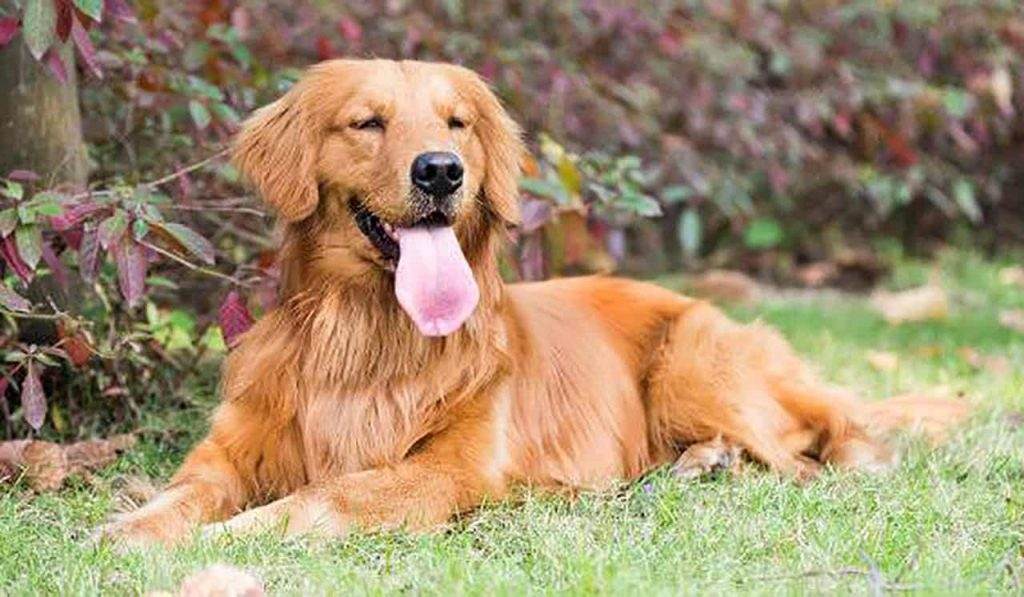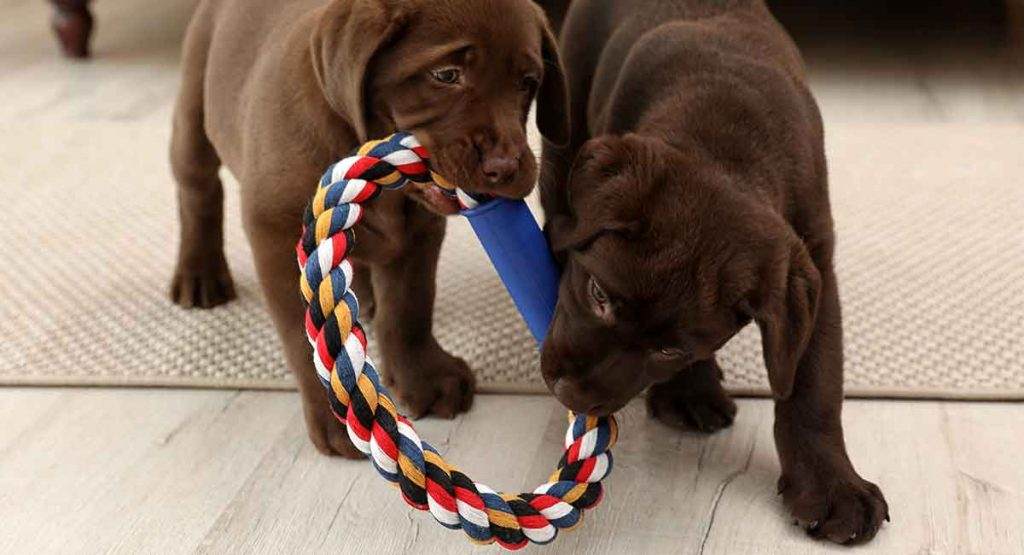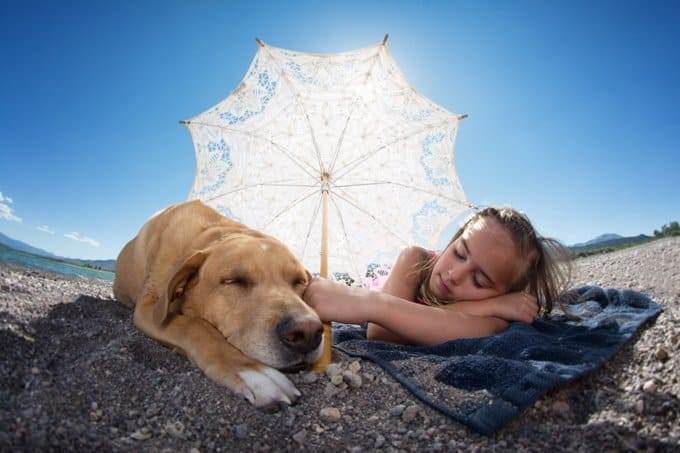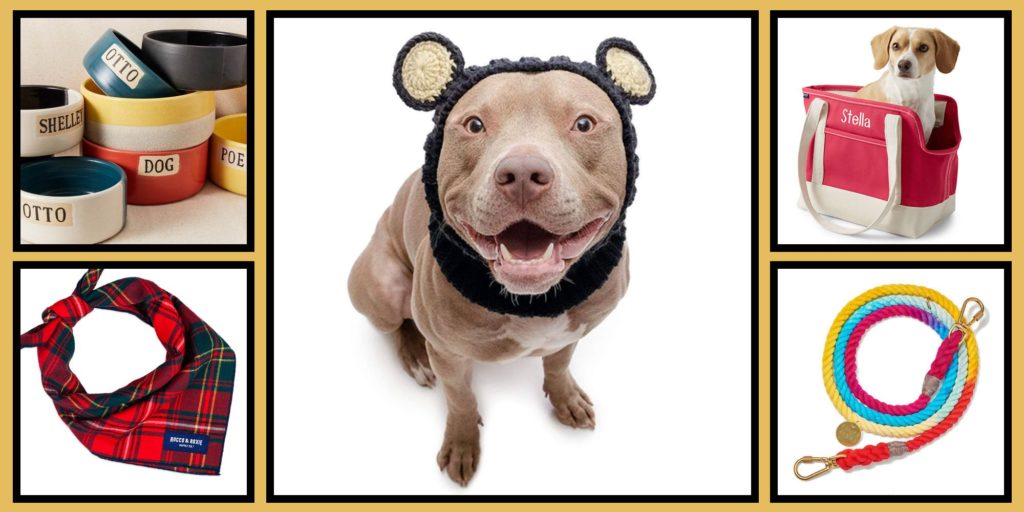While preparing the lost dog emergency plan, it is important to have some identification like ID card, photo, and description of your dog ready. Also, let the dog wear a GPS tracker device.
In case your dog is already lost then you should get some posters ready and also post for the lost dog on the internet especially in local Facebook groups. It is good practice to always keep your phone charged so that you can receive any “found your dog” calls.
Losing their dog is every pet owner’s worst nightmare. Whether they’ve escaped out of a back gate, startled by thunder on a walk, or even high-profile cases like Cooper, the West Jet dog, who escaped airport staff and ran away.
As a firefighter, I’ve been to motor vehicle collisions where a dog has been in the vehicle and they weren’t appropriately restrained. After the collision, they ran away because it was so terrifying for them.
What You Can Do As a Precaution?
We’ve put together a list of five things you can do to prepare for a lost dog emergency.
Treat all the following things as mandatory but having a strong emotional bond with your dog helps long way in times of crisis.
#1 Prepare A Checklist
The first thing you want to make sure is to prepare a checklist for the event of a lost dog. In the unfortunate event that your dog goes missing, you don’t want to search for ideas or google a strategy of some kind. So it’s really important that you have a checklist in place that includes things like:
- The information you’re going to share on social media
- Contact information for local search groups and local shelters
- Contact information for any local veterinary clinics that you’re going to distribute your information to.
#2 Multiple Forms of Identification
The next thing you want to be sure of is that your dog has multiple forms of identification. The old tried and tested method of having a collar and a tag is really great one. On that tag, you want to have your dog’s name, your home address, and a contact number.
Make sure it’s your cell phone number because if your dog does go missing, you won’t be waiting at home by the landline phone. You’re likely going out there and searching, so make sure your cell phone number is the number to contact on that tag.

#2.1 Microchips Are A Trend : But You Need to Know These Important Points
Scanner Issues
Microchips are a wise investment but the reality is that your dog needs to be found by an organization that has a scanner. While most countries have standardized the type of technology that the microchips are using, in the U.S.A there are actually three types of proprietary microchip technologies.
So your dog may be found by an organization that has a scanner but it isn’t necessarily the same kind of scanner to read your dog’s microchip.
First You Need To Get Your Dog Registered
The other thing is that your dog needs to be registered in a database and a lot of the veterinarians and shelters will immediately register your dog. But sometimes the veterinarian leaves it up to the pet owner. Without you uploading that information to some kind of registry, a microchip is essentially useless.
#3 Record, Store and Update All Information Safely
Now I can’t stress this enough, it’s really important to be prepared. With good preparedness, you’re able to maximize that initial search. You want to have things ready, like
- The dog’s height
- Weight
- Any distinct markings
- Any medication if that’s something that might be applicable
- Pertinent information that may help you expedite the return of your dog.
And when I talk about photos, we all have a million photos of our dogs as dog owners. You would have already posted ton of pictures of your dog on your or his/her Instagram account. But do really make sure that if your dog has a unique marking on their side, that you take a good picture of that.
Also that the pictures are well lit and that they’re readily available. I talked about it earlier but make sure in that checklist that you have all of those things ready to go at a moment’s notice.
#4 Prepare an Action Plan
Grid Search
Have a list of reference materials ready, maybe research how to do a grid search and have that listed on your reference materials. If you have some idea of where they might be, a grid search is a pretty effective way to really clear an area or track down a dog .
Instructions to Use Technology
Maybe you’ve used a tracking collar or one of those little key tags, little tags that go on your pet’s collar. Keep the instruction manual for those collars handy so you clearly know how to use it.
Emergency Contact Nos.
On your list of reference materials, maybe you have a contact that you can use as a live trap. Or you can contact media or a local radio station or television station. Have those contacts listed as reference materials and it can really expedite getting the word out.
How to Make Lost Dog Poster
I know it may seem strange but make sure you have your lost dog poster ready ahead of time. The last thing you want to be doing is sitting at home on your computer trying to put together the right pictures and right information.
When actually you know that your dog could be just a couple of kilometers away. So make sure you put things like the dog’s home address, your name, your cell phone number. As we mentioned earlier about using your own mobile number because you want to be out there and searching.
That way, you can distribute it to your friends, share it to social media sites and get out for searching immediately.
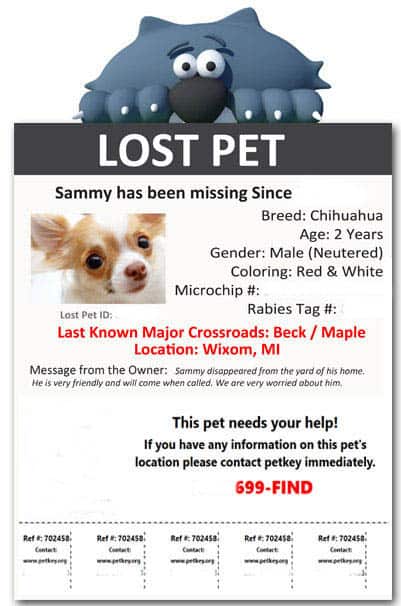
#5 Take Advantage Of Social Media
Use Facebook and social media websites to your advantage. There’s lot of free sites and programs which are alternative to Facebook. But I feel that Facebook is probably the easiest way to get the word out.
If you create a lost dog group, it’s an easy way to share the information. It’s also really helpful that people can join the group and say, “Listen, I’ve searched “this intersection,” or “I’ve been through these farm “fields and didn’t find anything.” It really helps you narrow down your search fast.
What Will You DO When You Have Actually Lost Your Dog
Finding Your Lost Dog – Day 1 Activities
Friendly Dog
- Search the immediate surroundings (yard, house, etc.). Call the dog by name.
- Call out the dog’s favorite verbal expressions, such as “Treat” or “go for a walk.”
- At the location where the dog left from, leave the dog’s beddings or any clothing that has your scent.
- Place food, water, and crate in the compound.
- If practical, leave the doors the dog uses to enter and exit the house open.
- Ask neighbors and friends to help with the search. They may help by foot, bike or car.
- Inform the volunteers not to chase.
- If you have other dogs, take them with you to the search.
- Carry a leash and treats for the dog. Carry a photo of the dog so that you can show volunteers.
Bonus Tip: Put a sign on the car window that says “Lost Dog” and drive around the area with flashers on.
Shy Dog
- Inform the search volunteers not to chase. Indicate “Do Not Chase” on all search signs and flyers.
- Do not yell the dog’s name.
- Inform the search team to use calming signals only. If anyone spots the dog, sit quietly.
- Avoid making eye contact with the shy dog. She could perceive it as aggression.
- Stoop down when approaching.
- Use food to lure the dog. Drop the food or toss it to the dog’s side and step away. Do not throw the food directly at the dog.
- If the dog fails to come to you after lots of effort, you might have to set a humane trap where the dog was last seen. Such a trap can be borrowed from animal control or local pet shelters. You may also rent the trap from a local equipment rental store. Search online for humane and effective ways of trapping a lost dog.
- Carry treats and slip leads to the search. Ensure that the slip leads are easy to use without the need for fastening a leash.
Bonus Tip: move away from the dog by either walking, jogging or running, and see whether she will follow you. This way, the shy dog won’t feel threatened as compared to directly approaching her.
Finding Lost Dog After 24 Hours
- Create a search team by asking friends and family to help with the search. Look for recruit helpers offline or through social media to help in splitting up search duties.
- Post most of the flyers in areas that are farther away from where the dog was last seen.
- Have the demographics in your area as a top consideration when designing flyers. For instance, create the flyers in Spanish if the demographics suggest so.
- Expand the online search campaign.
- Carry a leash, treats, and handouts to the search. Make continuous patrols on foot and by car. Intensify the search activities in the periods 5 am to 8 am and 6 pm to 9 pm.
- Focus on areas where a dog might seek safety, such as parks, farms and wooded areas.
- Check whether there’s anyone with helpful information in the area regularly and in person. Move door to door in your neighborhood and leave hand tags on the doors.
- Have a sign on your car window. Ask friends and family to have posters as well.
After Day 1: Tracking Available Sightings
- If you receive any possible sightings, post more flyers in that particular neighborhood.
- Keep track of the dates and locations of the sightings. Use a map to note the areas with sightings.
- Increase the area where you post the flyers with a radius of 1 mile each day.
- Use Google maps to learn about the area of interest. Take note of wooded areas, railroad tracks, jogging trails, and other high probability zones. Divide the area into zones and search exhaustively from one zone to the other.
More Tips on Finding Your Dog
- Ask for permission to post yard signs from the people in the area of interest. Order yard signs from sign companies (you can find such companies online).
- Get a banner with crucial information and hang it in your front yard.
- Try to get volunteers who can hold signs at intersections. This can bring more visibility.
- Focus on early mornings (between 5 am and 8 am) and evenings (between 6 pm and 9 pm).
- Cook something with a strong aroma within the area of interest ( you can use a portable grill for this). Ensure that you have the necessary permission to do so.
- Use multiple ways to get the word out about your missing dog. Use community newsletters, bus stops, restaurants, gas stations, and community Facebook pages.
Dog Has Been Missing For a Week?
- Don’t give up – be persistent with the search. Dogs can survive harsh weather, and they will try and remain as safe as possible until you find them.
- Check with the sanitation department for reports of any deceased dogs.
- Continue with the social media search campaign.
- Reach out to highway patrol and local police department for any helpful information.
- Check lost and found pet websites regularly.
When Your Lost Dog Gets Back Home
- Take her to a veterinarian for a medical checkup.
- Remove all flyers, posters and web postings. Discontinue all search ads. Contact all agencies and inform them your dog has been found. Thank everyone for their assistance.
- Consider having your dog micro-chipped and having her wear tags on a collar or harness.
- Update the lost pets websites that your dog has been found.
Learn More With the Help of Video
Conclusion
Now we’ve been talking about how to prepare for a lost dog emergency and using these tips will greatly increase your efficiency in the first two hours following losing your dog.
References
- https://jvme.utpjournals.press/doi/pdf/10.3138/jvme.29.4.205
- https://avmajournals.avma.org/doi/abs/10.2460/javma.230.2.211
- https://www.mitpressjournals.org/doi/abs/10.1162/dram.2007.51.1.92
Table of Contents

